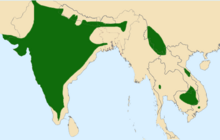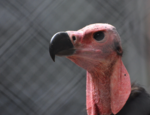| Red-headed vulture | |
|---|---|

| |
| Male in Bandhavgarh National Park, India | |
| Conservation status | |
 Critically Endangered (IUCN 3.1) | |
| Scientific classification | |
| Domain: | Eukaryota |
| Kingdom: | Animalia |
| Phylum: | Chordata |
| Class: | Aves |
| Order: | Accipitriformes |
| Family: | Accipitridae |
| Genus: | Sarcogyps Lesson, 1842 |
| Species: | S. calvus |
| Binomial name | |
| Sarcogyps calvus (Scopoli, 1786) | |

| |
| Current distribution range of red headed vulture | |
| Synonyms | |
| |
The red-headed vulture (Sarcogyps calvus), also known as the Asian king vulture, Indian black vulture or Pondicherry vulture, is an Old World vulture mainly found in the Indian subcontinent, with small disjunct populations in some parts of Southeast Asia.
Description
It is a medium-sized vulture of 76 to 86 cm (30 to 34 in) in length, weighing 3.5–6.3 kg (7.7–13.9 lb) and having a wingspan of about 1.99–2.6 m (6.5–8.5 ft). It has a prominent naked head: deep-red to orange in the adult, paler red in the juvenile. It has a black body with pale grey band at the base of the flight feathers. The sexes differ in colour of the iris: males have a paler, whitish iris, whilst in females it is dark brown.

The red-headed vulture is very similar in appearance to its larger relative the Lappet-faced vulture in Africa and Arabia, even being historically placed in the genus Torgos

 A female red-headed vulture (left) and a Lappet-faced vulture (right). Both have similar anatomical features including skull shapes and the dangling skin lappets. They are believed to be closely related
A female red-headed vulture (left) and a Lappet-faced vulture (right). Both have similar anatomical features including skull shapes and the dangling skin lappets. They are believed to be closely related
Taxonomy and systematics
This is a species of Old World vulture found in the Indian subcontinent. It has no subspecies.
Distribution and habitat
This gaudy-faced vulture was historically abundant, range widely across the Indian subcontinent, and also eastwards to south-central and south-eastern Asia, extending from India to Singapore. Today the range of the red-headed vulture is localized primarily to northern India. It is usually in open country and in cultivated and semi-desert areas. It is also found in deciduous forests and foothills and river valleys. It is usually found up to an altitude of 3000m from sea level.
Conservation status
Main article: Indian vulture crisisThe red-headed vulture used to be declining, but only slowly; in 2004 the species was uplisted to near threatened from least concern by the IUCN. The widespread use of the NSAID diclofenac in veterinary medicine in India has caused its population to collapse in recent years, however. Diclofenac is a compound now known to be extremely poisonous to vultures. The red-headed vulture population has essentially halved every other year since the late 1990s, and what once was a plentiful species numbering in the hundreds of thousands has come dangerously close to extinction in less than two decades. Consequently, it was uplisted to critically endangered in the 2007 IUCN Red List.
Several NSAIDs have been found to be harmful to scavenging birds. Diclofenac, carprofen, flunixin, ibuprofen and phenylbutazone were associated with mortality. Meloxicam has thus far been found to be "Vulture-Safe" and its use in veterinary treatment of livestock is being encouraged.
The red-headed vulture has become increasingly difficult to find due to hunting. In places like Cambodia, special programs have been implemented to support critically endangered vulture species. Evidence has shown that hunters have started using poisons in their hunting practices. Population analysis indicates that since 2010, populations of the White-rumped Vulture (Gyps bengalensis) and Red-headed Vulture (Sarcogyps calvus) have declined, while the Slender-billed Vulture (Gyps tenuirostris) may have also begun to decline since 2013.
In an assessment made in 2021 assessed there are 2500-9999 mature individuals in the wild.
Threats
Pharmaceutical Toxins and Diclofenac
A significant factor in the rapid decline of Red-headed Vulture populations since the 21st century is the pharmaceutical NSAID diclofenac, used to treat livestock. This substance has proven highly toxic to vultures, leading to mortality from renal failure and visceral gout. Recent findings indicate that Red-headed Vulture populations in India have shown signs of recovery following a ban on diclofenac, suggesting the drug's adverse effects on the species.
Human Activities
Incidental mortality occurs in Cambodia due to the widespread use of poisons for catching fish or waterbirds at trapeangs (waterholes). Intentional poisoning for belief-based use has also been reported in Cambodia. Additionally, the logging of nesting trees, electrocution, and collisions with powerlines are potential threats to the species.
Competition Among Vulture Species
In the shared ecosystem, dominant vulture species like Gyps vultures have a competitive advantage in scavenging on carcasses. They typically outcompete the Red-headed Vulture for access to food resources, which can lead to food scarcity for the species. As a result, the Red-headed Vulture may have limited access to suitable feeding opportunities, potentially affecting its survival and contributing to its population decline.
References
- ^ BirdLife International (2021). "Sarcogyps calvus". IUCN Red List of Threatened Species. 2021: e.T22695254A205031246. Retrieved 30 August 2022.
- Ali, S. (1993). The Book of Indian Birds. Bombay: Bombay Natural History Society. ISBN 978-0-19-563731-1.
- WWF- Red-headed Vulture (2011).
- Raptors of the World by Ferguson-Lees, Christie, Franklin, Mead & Burton. Houghton Mifflin (2001), ISBN 0-618-12762-3
- Naoroji, Rishad (2006). Birds of Prey of the Indian subcontinent. pp. 282–287.
- "Vultures=29 September 2022". Researchgate.
- Ferguson-Lees, James; David A. Christie (2001-09-17). Raptors of the world. Houghton Mifflin Harcourt. pp. 443–444. ISBN 978-0-618-12762-7.
- Cuthbert, Richard; et al. (2007). "NSAIDs and scavenging birds: potential impacts beyond Asia's critically endangered vultures". Biology Letters. 3 (1). The Royal Society: 90–93. doi:10.1098/rsbl.2006.0554. PMC 2373805. PMID 17443974. Retrieved 11 May 2011.
- Milius, Susan (4 February 2006). . ScienceNews. 169 (#5): 70. Retrieved 11 May 2011.
- ^ Loveridge, Robin. “Poisoning Causing the Decline in South-East Asia’s Largest Vulture Population.”, 8 Mar. 2019, https://www.cambridge.org/core/journals/bird-conservation-international/article/poisoning-causing-the-decline-in-southeast-asias-largest-vulture-population
External links
| Genera of eagles, condors and their extinct allies | |||||||||||||||||||||||||||||||||||||||||||||||||||||
|---|---|---|---|---|---|---|---|---|---|---|---|---|---|---|---|---|---|---|---|---|---|---|---|---|---|---|---|---|---|---|---|---|---|---|---|---|---|---|---|---|---|---|---|---|---|---|---|---|---|---|---|---|---|
| |||||||||||||||||||||||||||||||||||||||||||||||||||||
| |||||||||||||||||||||||||||||||||||||||||||||||||||||
| |||||||||||||||||||||||||||||||||||||||||||||||||||||
| Taxon identifiers | |
|---|---|
| Sarcogyps calvus |
|


